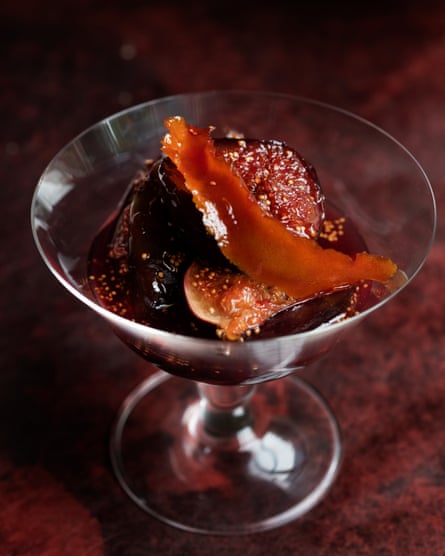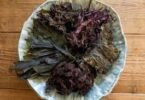Nigel Slater
You need a couple of minutes without any distractions to fry a batch of fresh curry leaves. You close the kitchen door, pour a thin film of oil into a wide, shallow-sided pan and place it over a moderate flame. Strip them from their coarse stems, then rain the tiny, emerald-green leaves into the hot oil and stand back while they crackle and pop, then gradually calm themselves. (A lid will help here, but remove it once they stop spluttering.) Shake the pan, watching carefully until each leaf is translucent and lightly crisp. Lift them out with a draining spoon on to a piece of kitchen paper.
You will be left with a pile of crackling, twisted, dark green leaves and a kitchen filled with a warm and smoky perfume. (I did suggest you close the door.) The window between perfection and burnt leaves is a heartbeat, so don’t take your eyes from the pan for a second. If you burn them – as I have done more than once – you will spend days getting rid of the smell.
I use curry leaves with lentil dishes (I love them in a turmeric-yellow dal) and scattered over a carrot or cucumber raita. Their presence is rarely crucial in a dish, but their scent is a delightful addition. I should add the dried version is no better than any other dried herb.
I made an aubergine and lentil dish this week that lasted a couple of days, something we ladled, steaming, into deep bowls, then went back to for seconds. And as the figs are still cheap and plentiful, I slipped a dish of them into the oven for later, soaked with a little sugar and a splash of sloe gin.
Lentils with aubergine and curry leaves
Deep, earthy flavours here. The dish is good eaten on the day it is made, but somehow even better when given time in the fridge overnight. Reheat it gently, on a low heat, stirring regularly. (You may need a little more stock just to loosen the texture.) Some steamed rice, perhaps with a little grated zest forked in, would be a splendid idea. A warming, fragrant supper that won’t break the bank. Serves 6
lentils 150g, small and brown
shallots 4, large
groundnut oil 2 tbsp, plus a little extra for later
ginger 50g, fresh
hot red chillies 2, medium-sized
ground cumin 1 tsp
ground coriander 1½ tsp
black mustard seeds 2 tsp
turmeric 2 tsp
tomatoes 350g
tomato paste 1 tbsp
curry leaves 20
garam masala 1 tbsp
stock or water 1 litre
aubergines 2, medium-sized
olive oil a little
Rinse the lentils in a sieve and set aside. Peel and finely chop the shallots. Warm the oil in a large saucepan, then add the shallots. Cook until they are soft and pale gold in colour – a matter of 7-10 minutes. Peel and grate the ginger and finely chop the chillies, removing the seeds if you wish. Add the ginger and chillies to the shallots and continue cooking, then stir in the cumin, coriander, mustard seeds and turmeric.
Roughly chop the tomatoes and stir them into the onions, followed by the tomato paste. Continue cooking for 5 minutes, then add the lentils, half the curry leaves and the garam masala. Pour in the vegetable stock or water. Season with salt and let the sauce simmer for 25 minutes, stirring regularly.
Cut the aubergines in half and then into 1cm-thick slices and toss them in a little olive oil, just enough to moisten them. Get a griddle pan (or overhead oven grill) hot, cook the aubergine slices for about 7-8 minutes on each side, then, as each piece softens and colours lightly, add them to the lentils. Continue cooking until the lentils are tender and the aubergine is soft and silky, which should take about 20 minutes.
Fry the reserved curry leaves until crisp in a tablespoon or two of groundnut oil in a shallow pan, then scatter them over and serve.
Figs in sloe gin

Figs take on the silkiest of textures when baked. I sometimes cook them in a shallow, earthenware dish with soft brown sugar and Marsala, or with crème fraîche and demerara, but I have found that a splash of sloe or damson gin is even more appropriate. The fruit emerges, a deep, glowing burgundy. I finish this particular version on the hob, heat turned high, to concentrate the cooking juices, so I suggest a roasting tin or baking dish that is flameproof, such as one made of stainless steel or enamelled cast iron. Serves 4
figs 6, medium-sized
orange 1
golden caster sugar 3 tbsp
sloe gin 90ml
Set the oven at 200C/gas mark 6. Cut the figs in half from stem to base and place them, just touching, in a baking dish. Using a vegetable peeler, remove 3 or 4 long pieces of zest from the orange, then halve and squeeze the fruit.
Tuck pieces of the orange zest among the figs, then scatter them with the sugar and pour over the orange juice and sloe gin. Bake for 30 minutes or until the fruit is soft and saturated with the gin.
Remove the figs from the oven. Place the baking tin over a moderate to high heat and let the juices bubble for a few minutes until they have reduced and are starting to thicken slightly. (Don’t overdo this, you don’t want them to caramelise.)
When they are jammy, place the figs into glasses or bowls and spoon the sloe sauce over them.
Courtesy: theguardian






